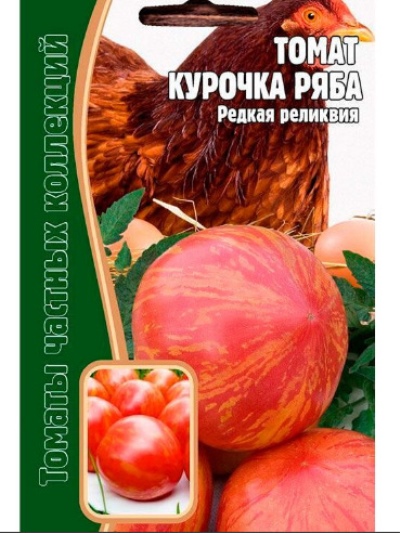
- Category: grade
- Growth type: determinant
- Appointment: fresh consumption, for pickling and preserving
- Ripening period: ultra early
- Transportability: Yes
- Bush size: undersized
- Bush height, cm: 30-50
- Stem: creeping
- Ripe fruit color: pinkish red with yellow stripes
- Fruit shape: rounded-elongated
Such a romantic and even referring to fairy-tale motives of the name of the variety does not allow it to be considered a bad choice. However, any tomato, no matter how promising, can reveal its capabilities only in skillful hands. And the skill itself, in turn, depends on familiarity with the characteristics of the variety no less than on diligence.
Description of the variety
The Chicken Ryaba tomato belongs to the determinant category. It is suitable for a wide variety of culinary uses. The bushes of this plant do not exceed 0.3-0.5 m in height, which makes it possible to almost abandon shelters even on hot days. An important varietal feature is the creeping stem.
The main qualities of the fruit
The berries of this variety are pinkish-red in color. It is diluted to some extent with yellow stripes. The fruit weighs an average of 100-150 g. It is similar in shape to a circle, but slightly elongated. The official description also emphasizes the excellent keeping quality of the crop and the possibility of transporting it without any problems.
Taste characteristics
The flesh of the Ryaba Chicken is dense. The fruits are used fresh. They are also good for canning. True, for some reason, in the available sources, a specific taste sensation from this plant is not characterized.
Ripening and fruiting
Tomato Chicken Ryaba is one of the ultra-early plants. However, the specific dates when it will be possible to wait for the harvest are not disclosed in the available materials. And also the expected time of fruit collection is not reflected.
Yield
According to reviews, the minimum efficiency is 5 kg per 1 sq. m. But even for such a result, you will have to make some efforts. It can be assumed that with the utmost diligence, the result will be even more favorable.
The timing of planting seedlings and planting in the ground
Usually, it is advised to plant the seeds of this plant in March. One has only to be a little late - and you will no longer be able to take advantage of the very early development. The culture is most often grown in a seedless way. Seed germination lasts up to 5-6 years after purchase.

Growing tomato seedlings is an extremely important process, because it largely depends on whether the gardener can harvest at all. All aspects must be taken into account, from seedbed preparation to planting in the ground.
Landing scheme
The landing system is not displayed in the official description. Therefore, we can assume that summer residents themselves should choose it.

Growing and care
Removing stepchildren is not required under normal conditions. However, such a culture still requires periodically to put the plants in order so that they do not overgrow. It is worth noting that information about the cultivation of the Ryaba Chicken and caring for it is extremely scarce, both in official and third-party sources. Therefore, gardeners will have to find out a lot by experience. Initially, you should do the same as with other ultra-early tomatoes.
Planting times are adapted to local conditions and actual weather. They also take into account the forecast in the long term. It is necessary that at least severe cold is already absent. And also make sure before planting that the seedlings are strong and healthy enough. Due to its exposure to cold weather, when choosing seedlings, the culture will need to be hardened.
Especially early varieties of tomatoes, including the Ryaba Chicken, often produce a tasteless harvest. Dealing with this problem is easier than it sounds. It is enough just to feed the bushes thoroughly. Top dressing is applied periodically, according to the standard tomato schedule, as well as with an urgent need for nutrients from plants. Since autumn, the earth is dug up to 30 cm, but not turned over, so as not to disturb the fertile layer.
In the spring, they dig up the beds again to put potash fertilizers there. There are a number of other recommendations:
plant seedlings of ultra-early tomatoes only when the ground warms up steadily to +10 degrees;
in the second decade of development - feed the bushes with nitrophos;
repeat feeding with nitrophos against the background of setting the ovaries;
for the last time, when fruiting begins, add magnesium sulfate or potassium-based mixtures;
watering of ultra-early tomatoes, like all others, is carried out as the soil dries up;
it is better to orient the beds from west to east;
the first watering in normal weather is carried out a week after planting (earlier - only with the onset of a serious drought or in the heat);
it will be critical to remove weeds both in the aisles and in the near-trunk circle.




A plant needs different micronutrients at each stage of growth. All fertilizers can be divided into two groups: mineral and organic. Folk remedies are often used: iodine, yeast, bird droppings, eggshells.
It is important to observe the rate and period of feeding. This also applies to folk remedies and organic fertilizers.



























































































